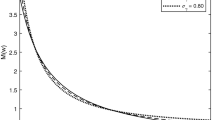Abstract
Since their introduction in 1973, options have become an important and very popular financial instrument. However, despite much research performed on the subject, the effects of option trading on the underlying asset market are still debated. Both empirical and theoretical studies have failed to point out how price volatility and volumes of the underlying asset are affected. In this paper we present the first study on the effects of an option market related to an underlying stock market, using an artificial financial market based on heterogeneous agents. We modeled a realistic European option using two market models. The microstructure of the first model is kept as simple as possible, being composed only of random traders. The second model is more complex and realistic, involving the presence of various kinds of trading strategies (random, fundamentalist and chartist). We show that the introduction of options, in the proposed models, tends to decrease the volatility of the underlying stock price. Moreover, the traders’ wealth can be strongly affected by the use of option hedging.
Similar content being viewed by others
References
Black F. and Scholes M.S. (1973). The pricing of options and corporate liabilities. Journal of Political Economy 81: 637–654
Bollen N.P.B. (1998). A note on the impact of options on stock return volatility. Journal of Banking and Finance 22: 1181–1191
Conrad J. (1989). The price effect of option introduction. Journal of Finance 44: 487–498
Fedenia M. and Grammatikos T. (1992). Options trading and the bid-ask spread of the underlying stocks. Journal of Business 65: 335–51
Hakansson N.H. (1982). Changes in the financial market: Welfare and price effects and the basic theorems of value conservation. The Journal of Finance 37: 977–1004
Heer B., Trede M. and Wahrenburg M. (1997). The effect of option trading at the dtb on the underlying stocks’ return variance. Empirical Economics 22: 233–245
Hull, J. C. (2005). Options, Futures, and other derivatives (6th edn.). Prentice-Hall International.
John, K., Koticha, A., & Subrahmanyam, M. (1994). The micro-structure of options markets: Informed trading, liquidity, volatility and efficiency. Working paper: New York University.
Kabir, R. (1997). The price and volatility effects of stock option introductions: A reexamination. Discussion paper, Tilburg University, Center for Economic Research. Available at http://ideas.repec.org/p/dgr/kubcen/199737.html.
Kumar R., Sarin A. and Shastri K. (1998). The impact of options trading on the market quality of the underlying security: An empirical analysis. The Journal of Finance 53: 717–732
Loistl, O. (2000). Kapsyn computer-modelled stock exchanges. Manual available at http://ideas.repec.org/p/fip/fedgif/597.html.
Mannaro, K., Marchesi, M., & Setzu, A. (2005). The impact of transaction taxes on traders’ behaviour and wealth: A microsimulation. WEHIA 2005, 13–15 June, United Kingdom: Essex.
Mannaro, K., Marchesi, M., & Setzu, A. (2007). Using an artificial financial market for assessing the impact of tobin-like transaction taxes. Journal of Economic Behavior & Organization (Forthcoming).
Merton R. (1973). The theory of rational option pricing. Bell Journal of Economics and Management Science 4: 141–183
Niehaus, F. (2001). The influence of heterogeneous preferences on asset prices an an incomplete market model. Computing in Economics and Finance, 60. Universiteit van Amsterdam, Center for Nonlinear Dynamics in Economics and Finance.
Palmer R., Arthur W., Holland J., LeBaron B. and TaylorP. (1994). Artificial economic life: A simple model of a stockmarket. Physica D. Nonlinear Phenomena 75: 264–274
Pierre E.F.S. (1998). The impact of option introduction on the conditional return distribution of underlying securities. The Financial Review 33: 105–118
Raberto M., Cincotti S., Focardi S. and Marchesi M. (2001). Agent-based simulation of a financial market. Physica D. Nonlinear phenomena 299: 319–327
Raberto M., Cincotti S., Focardi S. and Marchesi M. (2003). Traders’ long-run wealth in an artificial financial market. Computational Economics 22: 255–272
Ross S. (1976). Options and efficiency. Quarterly Journal of Economics 90: 75–89
Skinner D. (1989). Options markets and stock return volatlity. Journal of Financial Economics 23: 61–78
Sorescu S.M. (2000). The effect of options on stock prices: 1973 to 1995. Journal of Financial 55: 487–514
Tompkins R. (2001). Implied volatility surfaces: uncovering regularities for options on financial futures. European Journal of Finance 7: 198–230
Wei P., Poon P.S. and Zee S. (1997). The effect of option listing on bid-ask spreads, price volatility and trading activity of the underlying otc stocks. Review of Quantitative Finance and Accounting 9(2): 165–180
Author information
Authors and Affiliations
Corresponding author
Rights and permissions
About this article
Cite this article
Ecca, S., Marchesi, M. & Setzu, A. Modeling and Simulation of an Artificial Stock Option Market. Comput Econ 32, 37–53 (2008). https://doi.org/10.1007/s10614-008-9134-6
Received:
Accepted:
Published:
Issue Date:
DOI: https://doi.org/10.1007/s10614-008-9134-6




